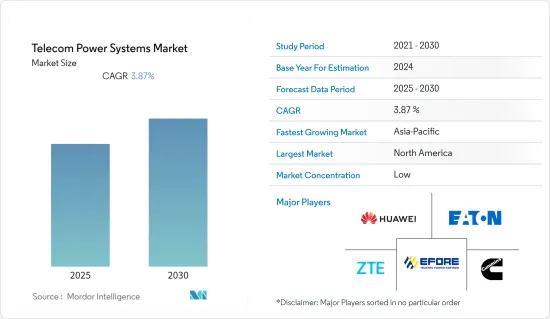
|
시장보고서
상품코드
1683196
통신 전력 시스템 : 시장 점유율 분석, 산업 동향 및 통계, 성장 예측(2025-2030년)Telecom Power Systems - Market Share Analysis, Industry Trends & Statistics, Growth Forecasts (2025 - 2030) |
||||||
통신 전력 시스템 시장은 예측 기간 동안 CAGR 3.87%를 나타낼 것으로 예상됩니다.

주요 하이라이트
- 통신 전력 시스템은 정류기, 배터리, 전원 시스템 컨트롤러로 구성되며, 그리드 전력 공급의 중단이나 변동에 대비하여 통신 서비스를 보장합니다. 통신 전력 시스템 시장은 세계 여러 지역에 더 많은 타워가 설치되고 있는 것이 주요 요인으로 작용하고 있습니다. 그 배경에는 기술의 변화 등 다양한 요인이 있습니다.
- 4G 및 5G와 같은 차세대 기술이 도입됨에 따라 타워 설치에 대한 수요가 증가하면서 시장을 주도하고 있습니다. 그러나 여러 지역에서 4G 및 5G 기술의 커버리지가 상대적으로 낮기 때문에 통신사는 음성 및 데이터 트래픽 증가에 대응하기 위해 더 많은 타워를 설치해야 합니다. 기술이 발전함에 따라 사람들의 속도에 대한 수요도 증가하고 있습니다. 초기에는 커버리지가 충분하지 않아 속도에 편차가 있었지만, 지금은 달라지고 있습니다.
- 태양에너지의 활용은 주요 전력망을 벗어난 외딴 지역, 예를 들어 전력이 공급되지 않는 산 정상이나 광활한 습지 등 새로운 송전선로를 설치하는 것이 현실적이지 않은 곳에서 통신 시스템에 전력을 공급할 수 있는 안정적인 방법입니다. 이러한 전개는 이 시장의 향후 추세가 될 수 있습니다.
- 특히 신흥 경제국에서 정전은 최신 액세스 기술 도입에 큰 장애물이 되고 있습니다. GSMA의 새로운 연구에 따르면, 2025년까지 MENA 지역에서 5,000만 개 이상의 5G 연결이 가능해질 것이며, 그 때쯤이면 이 지역 인구의 약 30%가 5G 네트워크에 접속할 수 있게 될 것이라고 합니다. 커버될 것이라고 합니다.
- 또한, 원격 통신 시스템용 재생 가능 에너지원은 기술 발전과 비용 감소로 인해 최근 인기가 높아지고 있습니다. 바람이나 태양과 같은 재생 가능 자원은 유용한 에너지를 제공하고, 시스템 인프라를 운영하는 전체 비용을 낮추며, 이산화탄소 배출량을 줄입니다.
코로나19 사태로 인해 브로드밴드 트래픽이 증가하면서 통신업계의 인프라 확장 계획이 잇따르고 있습니다. 국제전기통신연합(ITU)에 따르면, 코로나19 팬데믹으로 인한 트래픽 증가는 용량 확장(즉, 운영 및 유지보수 CAPEX)으로 인한 자본 지출(CAPEX)의 가속화를 가져왔습니다고 합니다. 자본 지출 증가는 새로운 전력 시스템의 필요성으로 이어지고 있습니다.
통신 전력 시스템 시장 동향
5G 액세스 용도이 시장에서 큰 점유율을 차지합니다.
- 5G는 최근의 무선 광대역 기술이며, 5세대 무선 기술로 판매되고 있습니다. 비트 레이트는 다운링크에서 100MB/s에서 최대 20GB/s의 피크 데이터 속도를 갖는 것이 기업의 목표가 되고 있습니다. 5G는 450MHz에서 6GHz까지의 sub-6GHz 스펙트럼과 24GHz에서 52GHz까지의 mmWave 주파수를 채택하고 있으며, 300MB/s의 속도는 아직 실용화되지 않았습니다.
- 이처럼 단기간에 5G의 보급이 빠르게 진행되는 것은 더 많은 셀 사이트 구축을 촉진하기 때문에 조사 대상 시장에 큰 촉진요인이 될 수 있습니다. 이러한 인프라 개선은 이 지역의 일부 국가에서만 일어나는 것이 아니라 많은 국가에서 일어나고 있습니다.
- 전 세계적으로 데이터 트래픽이 증가함에 따라 5G 연결은 업무 효율성을 보장하고 업무 위반에 따른 손실을 최소화하기 위해 많은 기업들이 도입할 것으로 예상되며, 5G 네트워크는 사물인터넷(IoT), 농업 분야에서 독립적으로 작동하는 실외 로봇 등 다양한 기술을 지원합니다. 다양한 기술을 지원합니다.
- 동아엘렉콤은 빠르게 발전하고 다기능화되는 통신 산업을 위해 정류기 및 핫스왑 전원 모듈, 전원 선반, 에너지 시스템을 공급하고 있으며, 동아엘렉콤의 전력은 국내 3대 통신사업자의 4G/LTE 스몰셀 구축을 지원하고 있습니다. 한국통신(Korea Telecom), SK텔레콤(SK Telecom), LG유플러스(LGU+)는 3년 동안 한국 전역에 30만개 이상의 스몰셀 시스템을 구축하였습니다.
- 에릭슨에 따르면, 모바일 데이터 트래픽의 총량은 전 세계적으로 계속 증가하여 2024년 말에는월131 엑사바이트에 달했습니다. 이는 2018년부터 2024년까지 30%의 연평균 복합 성장률(CAGR)을 의미하며, 2024년까지 5G 네트워크가 전체 모바일 데이터 트래픽의 35%를 차지했습니다.
예측 기간 동안 통신 전력 시스템 시장은 5G 기술이 비즈니스에 사용되기 위해 필요한 인프라 구축에 대한 투자에 의해 주도될 가능성이 높습니다.
북미가 큰 시장 점유율을 차지합니다.
- 북미는 대부분의 신기술이 가장 먼저 활용되는 곳 중 하나이며, 통신 기술도 예외는 아닙니다. 북미에서는 94%의 사람들이 휴대전화를 가지고 있습니다.
- 에릭슨에 따르면, 2025년 말까지 5G 휴대폰 가입 건수는 3억 1,800만 건에 달할 것으로 예상되며, 이는 북미 전체 휴대폰 가입 건수의 80% 이상에 해당합니다. 이는 통신 전력 시스템에 대한 수요를 증가시킬 수 있습니다.
- 따라서 용량, 커버리지, 효율성 측면에서 미래의 5G 서비스 수요를 충족시키기 위해 미국 네트워크 사업자들은 비트당 비용을 최소화하면서 최고의 성능을 얻기 위해 네트워크에 투자하고 있습니다. 이를 위해 네트워크 기능 가상화(NFV)와 소프트웨어 정의 네트워킹(SDN)과 같은 신기술을 활용하여 네트워크를 최대한 효율적으로 운영함으로써 이를 실현하고 있습니다.
이러한 기술의 발전은 더 높은 주파수를 사용하여 최종 사용자에게 인터넷 속도를 향상시킬 수 있기 때문에 이러한 기술의 채택이 증가하는 근거는 통신 전력 시스템 시장 성장 촉진요인이 될 수 있습니다. 높은 주파수를 사용하면 네트워크의 커버리지가 좁아집니다. 이는 모든 고객을 커버하기 위해 더 많은 이동식 철탑을 설치해야 한다는 것을 의미하며, 이는 결국 통신 전력 시스템 시장을 견인할 것입니다.
통신 전력 시스템 산업 개요
통신 전력 시스템 시장은 4G LTE 시스템의 등장으로 세분화되고 있습니다. 앞으로 더 많은 기업이 등장하고 시장 경쟁은 더욱 치열해질 것으로 보입니다. 주요 기업은 Eaton Corporation, Huawei Technologies Co., Cummins Inc.
2022년 5월, 화웨이는 차세대 전원 솔루션 PowerPOD 3.0의 출시를 발표했습니다. 혁신적인 컨버지드 아키텍처와 업계 초 고밀도 UPS5000-H를 채택하여 캐비닛 당 전력 밀도를 높이고 전원 공급 시스템의 공간 레이아웃을 개선했습니다.
2022년 5월, 에릭슨은 Deutsche Telekom의 5G 지원 네트워크 시험이 순조롭게 진행되고 있다고 발표했습니다. 이는 재생 가능 에너지를 이용하고 수요 및 공급의 균형을 유지함으로써 모바일 사이트 운영을 보다 지속 가능하게 만드는 데 큰 도움이 될 수 있습니다.
기타 혜택
- 엑셀 형식 시장 예측(ME) 시트
- 3개월간의 애널리스트 지원
목차
제1장 서론
- 조사의 전제조건과 시장 정의
- 조사 범위
제2장 조사 방법
제3장 주요 요약
제4장 시장 인사이트
- 시장 개요
- 산업 밸류체인 분석
- 업계의 매력 - Porter의 Five Forces 분석
- 신규 진출업체의 위협
- 바이어의 교섭력
- 공급 기업의 교섭력
- 대체품의 위협
- 경쟁 기업간 경쟁 관계
- 시장에 대한 COVID-19의 영향
제5장 시장 역학
- 시장 성장 촉진요인
- 시장 성장 억제요인
제6장 기술 현황
- 전력
- 컨버터
- 정류기
- 제어 및 감시 어셈블리
- 캐비닛
- 배터리 관리 툴
제7장 시장 세분화
- 출력 범위별
- 저
- 중
- 고
- 최종사용자 용도별
- 액세스
- 코어
- 메트로
- 지역별
- 북미
- 유럽
- 아시아태평양
- 라틴아메리카
- 중동 및 아프리카
제8장 경쟁 구도
- 기업 개요
- Eaton Corporation
- Huawei Technologies Co.
- Cummins Inc.
- ZTE Corporation
- Efore Group
- Eltek AS
- Delta Group
- Alpha Technologies
- ABB Group
- Schneider Electric
제9장 투자 분석
제10장 시장 기회와 향후 동향
LSH 25.03.27The Telecom Power Systems Market is expected to register a CAGR of 3.87% during the forecast period.

Key Highlights
- Telecom power systems comprise rectifiers, batteries, and a power system controller, and they secure telecommunication services in case of grid power interruptions and fluctuations. The telecom power systems market has been mostly driven by the fact that more towers are being put up in different parts of the world. This is due to a number of factors, including changing technologies.
- The increasing need for tower installations is driving the market as the following technologies, such as 4G and 5G, are being deployed. Still, the coverage is relatively lower for 4G and 5G technologies in various regions, so telecom companies need to set up more towers to handle the growing voice and data traffic. As technology improves, so does people's need for speed. At first, speed would vary because there wasn't enough coverage, but that's changing now.
- Using solar energy is a steady method of providing electrical power to telecommunication systems in remote places beyond the main electricity grid, for instance, on mountaintops and vast swamps where power is unavailable or it is impractical to install new power lines. This deployment may become a future trend in this market.
- Power outages, especially in developing economies, have been a major roadblock to adopting the latest access technologies. This problem has irritated service providers, cell site operators, and owners all over the world. A new GSMA study says that there could be more than 50 million 5G connections in the MENA region by 2025 and that about 30% of the region's population will be covered by 5G networks by that time.
- Additionally, renewable energy sources for remote telecommunication systems have become more popular recently due to technological advancements and lower costs. Renewable resources, like the wind and the sun, provide useful energy, lower the overall costs of running the system's infrastructure, and leave less of a carbon footprint.
The COVID-19 pandemic also led to the growth of broadband traffic, leading to several infrastructure expansion plans by the telecom industry. According to the International Telecommunication Union (ITU), the increase in traffic due to the COVID-19 pandemic resulted in an acceleration of capital expenditure (CAPEX) via the expansion of capacity (i.e., operations and maintenance CAPEX). The increased capital expenditure has led to a need for new power systems.
Telecom Power Systems Market Trends
Access Application in 5G Holds the Significant Share in the Market
- 5G is a recent wireless broadband technology and is marketed as the fifth generation of radio technologies. There is a target for the firms for the bit rate to have peak data rates of 100 MB/s up to 20 GB/s in the downlink. However, 300 MB/s rates have yet to be achieved in practical implementations. 5G employs a sub-6 GHz spectrum ranging from 450 MHz to 6 GHz as well as mmWave frequencies ranging from 24 GHz to 52 GHz.
- This increasing penetration of 5G in such a short span of time can be a major driver for the market studied, as this will fuel the deployment of more cell sites. This improvement in infrastructure isn't just happening in a few countries in the area; it's happening in many.
- With increasing data traffic globally, 5G connectivity will be incorporated in many enterprises to ensure operational efficiency and minimize losses associated with operational breaches. The 5G network will support a variety of technologies, including the Internet of Things (IoT), outdoor robots that can function independently in the agriculture sector, etc.
- DongAh Elecomm supplies rectifier and hot-swap power supply modules, power shelves, and energy systems for the fast-developing and multi-functionalized communications industry. DongAh Elecomm's power is behind the 4G/LTE small cell deployment for South Korea's three major service providers: Korea Telecom, SK Telecom, and LGU+, which deployed more than 300,000 small cell systems across the Republic of Korea over three years.
- According to Ericsson, total mobile data traffic may continue to increase globally and is predicted to reach 131 exabytes per month by the end of 2024. This implies a 30% compound annual growth rate between 2018 and 2024. By 2024, the firm expects that 5G networks will carry 35% of total mobile data traffic.
During the forecast period, the market for telecom power systems is likely to be driven by investments in building the infrastructure needed for 5G technology to be used in the business world.
North America Account for Significant Market Share
- North America has been one of the first places to use most new technologies, and telecom technologies are no exception. In North America, 94% of people have a mobile phone.
- Ericsson says that by the end of 2025, there will be 318 million 5G mobile subscriptions, which is more than 80% of all mobile subscriptions in North America. This may increase the demand for telecom power systems.
- So, to meet the needs of future 5G services in terms of capacity, coverage, and efficiency, network operators in the United States are investing in their networks to get the best performance at the lowest cost per bit. They are doing this by using new technologies like network function virtualization (NFV) and software-defined networking (SDN) to make their networks as efficient as possible.
The rationale behind the increasing adoption of these technologies can be a driving factor for the telecom power systems market, as advancements in these technologies bring increased internet speeds for end users, which are achieved by the use of higher frequencies. When higher frequencies are used, network coverage gets smaller. This means that more mobile towers need to be set up to cover all customers, which will eventually drive the telecom power systems market.
Telecom Power Systems Industry Overview
The telecom power systems market is fragmented with the advent of 4G LTE systems. There will be more players added, which will increase the market's competition. Key players are Eaton Corporation, Huawei Technologies Co., and Cummins Inc.
In May 2022, Huawei announced the launch of a new generation of power supply solutions, PowerPOD 3.0. By using an innovative converged architecture and the industry's ultra-high-density UPS5000-H, the power density per cabinet is increased, and the space layout of the power supply system is improved.
In May 2022, Ericsson announced that a trial of Deutsche Telekom's 5G-enabled network had gone well. This could be a big step toward making mobile site operations more sustainable by using renewable energy and balancing supply and demand.
Additional Benefits:
- The market estimate (ME) sheet in Excel format
- 3 months of analyst support
TABLE OF CONTENTS
1 INTRODUCTION
- 1.1 Study Assumptions and Market Definition
- 1.2 Scope of the Study
2 RESEARCH METHODOLOGY
3 EXECUTIVE SUMMARY
4 MARKET INSIGHTS
- 4.1 Market Overview
- 4.2 Industry Value Chain Analysis
- 4.3 Industry Attractiveness - Porter's Five Forces Analysis
- 4.3.1 Threat of New Entrants
- 4.3.2 Bargaining Power of Buyers
- 4.3.3 Bargaining Power of Suppliers
- 4.3.4 Threat of Substitute Products
- 4.3.5 Intensity of Competitive Rivalry
- 4.4 Impact of COVID-19 on the Market
5 MARKET DYNAMICS
- 5.1 Market Drivers
- 5.1.1 Increasing Need for Tower Installations
- 5.1.2 Adoption of Hybrid Power System in Telecom
- 5.2 Market Restraints
- 5.2.1 High Deployment and Operational Cost
6 TECHNOLOGY SNAPSHOT
- 6.1 Power Supply
- 6.2 Converters
- 6.3 Rectifiers
- 6.4 Control and Monitoring Assemblies
- 6.5 Cabinetry
- 6.6 Battery Management Tools
7 MARKET SEGMENTATION
- 7.1 By Power Range
- 7.1.1 Low
- 7.1.2 Medium
- 7.1.3 High
- 7.2 By End-user Application
- 7.2.1 Access
- 7.2.2 Core
- 7.2.3 Metro
- 7.3 By Geography
- 7.3.1 North America
- 7.3.2 Europe
- 7.3.3 Asia Pacific
- 7.3.4 Latin America
- 7.3.5 Middle East and Africa
8 COMPETITIVE LANDSCAPE
- 8.1 Company Profiles
- 8.1.1 Eaton Corporation
- 8.1.2 Huawei Technologies Co.
- 8.1.3 Cummins Inc.
- 8.1.4 ZTE Corporation
- 8.1.5 Efore Group
- 8.1.6 Eltek AS
- 8.1.7 Delta Group
- 8.1.8 Alpha Technologies
- 8.1.9 ABB Group
- 8.1.10 Schneider Electric



















